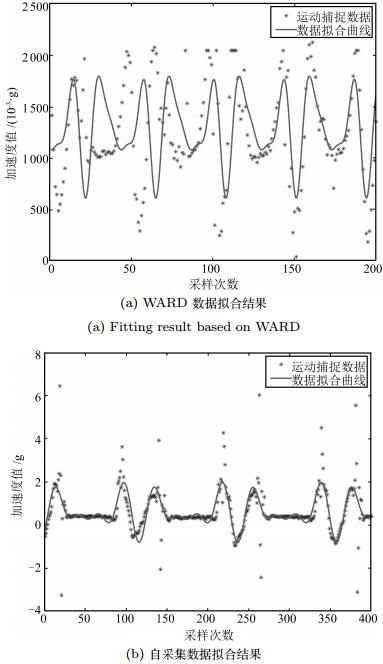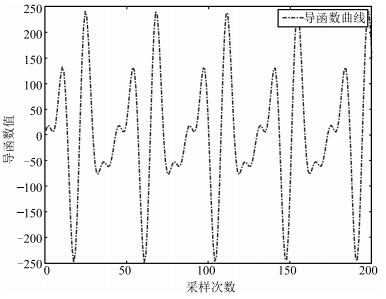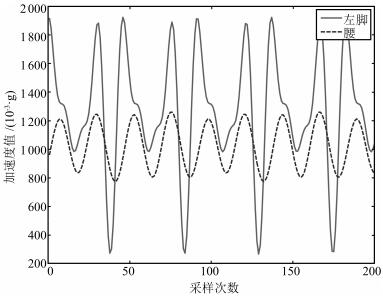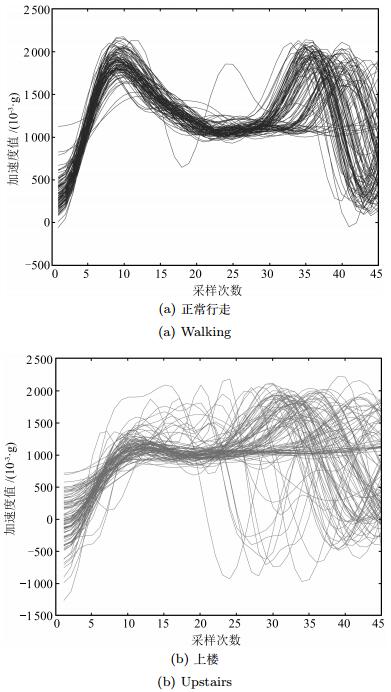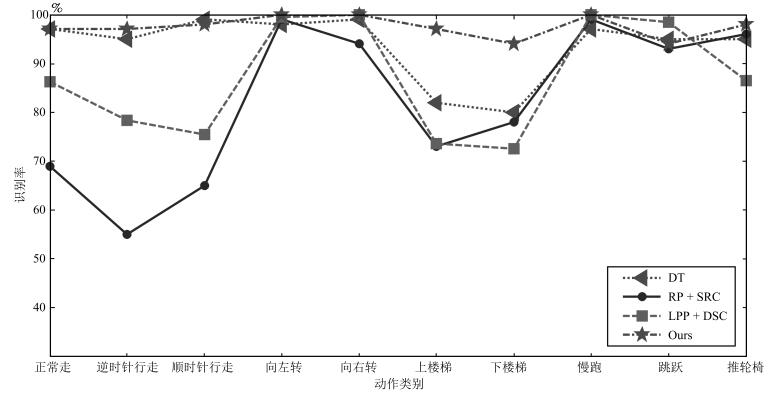-
摘要: 人体运动过程中,肢体的运动是连续的,而对应的运动捕捉数据是离散的.为了更好地分析人体日常运动行为的连续性与周期性,本文提出了一种基于函数型数据分析(Functional data analysis,FDA)的人体动态行为识别方法.首先,利用函数型数据分析方法,将可穿戴式运动捕捉系统采集的人体周期行为数据函数化,通过函数准确地定义数据的连续性与周期性;然后,根据导函数信息确定一个运动周期的起始点,并近似地提取出一个运动周期的数据序列;最后,根据不同行为一个周期内的曲线特征差异,利用支持向量机对动态行为进行分类识别.实验结果表明,本文的算法既能够较好地描述人体动态行为的连续性与周期性,又使得运动数据在标定的统一起始点处对齐,且在WARD数据集与自采集数据集上均取得了较好的识别率,分别达到97.5%与98.75%.
-
关键词:
- 动态行为识别 /
- 连续性与周期性 /
- 周期行为 /
- 函数型数据分析 /
- 可穿戴式运动捕捉系统
Abstract: In human motion, limb movement is continuous. However, the corresponding motion capture data is discrete. This paper explores a method for human dynamic action recognition based on functional data analysis (FDA) so as to analyze the continuity and periodicity of daily action. Firstly, we transform the periodic data collected by the wearable motion capture system into functional data using FDA, and then define the continuity and periodicity of data exactly by using function properties. Secondly, we determine the initial point of a motion period according to the derivative information, and then extract the data series representing a period of motion. Finally, we utilize support vector machine (SVM) to classify the dynamic action according to the different characteristics of the curves about different actions in a period. The experimental result indicates that our algorithm can describe the continuity and periodicity of human dynamic action, and align the motion data at the uniform start point we determined. At the same time, desirable recognition rates, such as 97.5% and 98.75%, can be achieved based on WARD and our database using our algorithm. -
表 1 WARD中的行为描述
Table 1 Description of the behaviors in WARD
编号 行为类别 行为描述 1 正常行走 向前走持续超过10秒 2 逆时针行走 逆时针走持续超过10秒 3 顺时针行走 顺时针走持续超过10秒 4 向左转 原地左转持续超过10秒 5 向右转 原地右转持续超过10秒 6 上楼梯 上超过10阶的楼梯 7 下楼梯 下超过10阶的楼梯 8 慢跑 慢跑持续超过10秒 9 跳 原地跳超过5次 10 推轮椅 推轮椅超过10秒 表 2 10种动态行为类别的混淆矩阵
Table 2 Confusion matrix of 10 dynamic action classes
1 2 3 4 5 6 7 8 9 10 识别率(%) 1 97 0 0 0 0 1 0 0 0 2 97 2 0 97 0 1 0 0 0 0 0 2 97 3 0 0 98 0 1 0 1 0 0 0 98 4 0 0 0 100 0 0 0 0 0 0 100 5 0 0 0 0 100 0 0 0 0 0 100 6 0 0 0 0 0 97 1 1 1 0 97 7 0 0 0 0 0 2 94 1 0 3 94 8 0 0 0 0 0 0 0 100 0 0 100 9 0 0 0 0 0 1 5 0 94 0 94 10 1 0 0 0 0 0 0 0 1 98 98 总识别率 97.5 表 3 基于WARD的算法结果对比
Table 3 Comparison with other methods based on WARD
表 4 不同分类器分类结果对比
Table 4 Comparison with other classifiers
分类器 识别率(%) 支持向量机 97.5 决策树 89.5 朴素贝叶斯 86.9 K-近邻 93.9 -
[1] Poppe R. A survey on vision-based human action recognition. Image and Vision Computing, 2010, 28(6): 976-990 doi: 10.1016/j.imavis.2009.11.014 [2] 王蒙, 戴亚平, 王庆林.单目视觉下目标三维行为的时间尺度不变建模及识别.自动化学报, 2013, 40(8): 1644-1653 http://www.aas.net.cn/CN/abstract/abstract18432.shtmlWang Meng, Dai Ya-Ping, Wang Qing-Lin. Time-scale invariant modeling and classifying for object behaviors in 3D space based on monocular vision. Acta Automatica Sinica, 2013, 40(8): 1644-1653 http://www.aas.net.cn/CN/abstract/abstract18432.shtml [3] Yang J, Wang S Q, Chen N J, Chen X, Shi P F. Wearable accelerometer based extendable activity recognition system. In: Proceedings of the 2010 IEEE International Conference on Robotics and Automation. Anchorage, AK, USA: IEEE, 2010. 3641-3647 [4] Preece S J, Goulermas J Y, Kenney L P J, Howard D. A comparison of feature extraction methods for the classification of dynamic activities from accelerometer data. IEEE Transactions on Biomedical Engineering, 2009, 56(3): 871-879 doi: 10.1109/TBME.2008.2006190 [5] He W H, Guo Y C, Gao C, Li X K. Recognition of human activities with wearable sensors. EURASIP Journal on Advances in Signal Processing, 2012, 2012(1): 108 doi: 10.1186/1687-6180-2012-108 [6] 李锋, 潘敬奎.基于三轴加速度传感器的人体运动识别.计算机研究与发展, 2016, 53(3): 621-631 doi: 10.7544/issn1000-1239.2016.20148159Li Feng, Pan Jing-Kui. Human motion recognition based on Triaxial accelerometer. Journal of Computer Research and Development, 2016, 53(3): 621-631 doi: 10.7544/issn1000-1239.2016.20148159 [7] Najafi B, Aminian K, Paraschiv-Ionescu A, Loew F, Bula C J, Robert P. Ambulatory system for human motion analysis using a kinematic sensor: monitoring of daily physical activity in the elderly. IEEE Transactions on Biomedical Engineering, 2003, 50(6): 711-723 doi: 10.1109/TBME.2003.812189 [8] Zhang M, Sawchuk A A. A feature selection-based framework for human activity recognition using wearable multimodal sensors. In: Proceedings of the 6th International Conference on Body Area Networks. Beijing, China: ICST, 2011. 92-98 [9] Ghasemzadeh H, Jafari R. Physical movement monitoring using body sensor networks: a phonological approach to construct spatial decision trees. IEEE Transactions on Industrial Informatics, 2011, 7(1): 66-77 doi: 10.1109/TII.2010.2089990 [10] Wang Z L, Jiang M, Hu Y H, Li H Y. An incremental learning method based on probabilistic neural networks and adjustable fuzzy clustering for human activity recognition by using wearable sensors. IEEE Transactions on Information Technology in Biomedicine, 2012, 16(4): 691-699 doi: 10.1109/TITB.2012.2196440 [11] Yang A Y, Jafari R, Sastry S S, Bajcsy R. Distributed recognition of human actions using wearable motion sensor networks. Journal of Ambient Intelligence and Smart Environments, 2009, 1(2): 103-115 [12] 肖玲, 李仁发, 罗娟.体域网中一种基于压缩感知的人体动作识别方法.电子与信息学报, 2013, 35(1): 119-125 http://www.cnki.com.cn/Article/CJFDTOTAL-DZYX201301018.htmXiao Ling, Li Ren-Fa, Luo Juan. Recognition of human activity based on compressed sensing in body sensor networks. Journal of Electronics and Information Technology, 2013, 35(1): 119-125 http://www.cnki.com.cn/Article/CJFDTOTAL-DZYX201301018.htm [13] Ramsay J O, Silverman B W. Functional Data Analysis. New York, USA: Springer-Verlag, 2005. [14] Ramsay J O, Silverman B W. Applied Functional Data Analysis: Methods and Case Studies. New York, USA: Springer, 2002. [15] 苏为华, 孙利荣, 崔峰.一种基于函数型数据的综合评价方法研究.统计研究, 2013, 30(2): 88-94 http://cdmd.cnki.com.cn/Article/CDMD-10353-1012336072.htmSu Wei-Hua, Sun Li-Rong, Cui Feng. One comprehensive evaluation method study based on functional data. Statistical Research, 2013, 30(2): 88-94 http://cdmd.cnki.com.cn/Article/CDMD-10353-1012336072.htm [16] 李淳芃, 王兆其, 夏时洪.人体运动的函数数据分析与合成.软件学报, 2009, 20(6): 1664-1672 http://www.cnki.com.cn/Article/CJFDTOTAL-RJXB200906025.htmLi Chun-Peng, Wang Zhao-Qi, Xia Shi-Hong. Motion synthesis for virtual human using functional data analysis. Journal of Software, 2009, 20(6): 1664-1672 http://www.cnki.com.cn/Article/CJFDTOTAL-RJXB200906025.htm [17] Chang C C, Lin C J. LIBSVM: a library for support vector machines. ACM Transactions on Intelligent Systems and Technology, 2011, 2(3): Article No. 27 [18] Boser B B, Guyon I M, Vapnik V N. A training algorithm for optimal margin classifiers. In: Proceedings of the 5th Annual Workshop on Computational Learning Theory. Pittsburgh, Pennsylvania, USA: ACM, 1992. 144-152 [19] MATLAB中文论坛. MATLAB神经网络30个案例分析.中国北京:北京航空航天大学出版社, 2010. 120-132 http://cdmd.cnki.com.cn/Article/CDMD-11912-2006063682.htmMATLAB Chinese Forum. MATLAB Neural Network 30 Case Analysis. Beijing, China: Beijing University of Aeronautics and Astronautics Press, 2010. 120-132 http://cdmd.cnki.com.cn/Article/CDMD-11912-2006063682.htm [20] Wright J, Yang A Y, Ganesh A, Sastry S S, Ma Y. Robust face recognition via sparse representation. IEEE Transactions on Pattern Analysis and Machine Intelligence, 2009, 31(2): 210-227 doi: 10.1109/TPAMI.2008.79 -





 下载:
下载:
